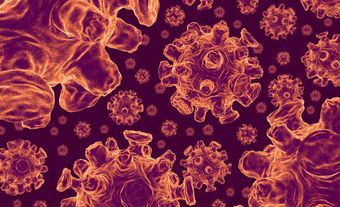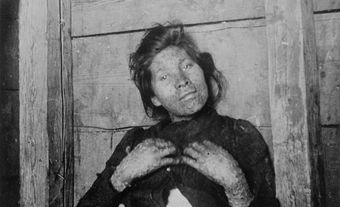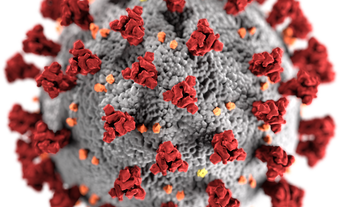Canada experienced an outbreak of severe acute respiratory syndrome (SARS) in 2003. Most of the infections originated in Toronto hospitals. The outbreak led to the quarantine of thousands, killed 44 people and took an economic toll on Toronto. It also exposed the country’s ill-prepared health-care system. Confusion around SARS fuelled an uptick in anti-Asian racism and anti-immigrant sentiment.
Click here for definitions of key terms used in this article.

What Is SARS?
SARS is an infectious disease caused by a coronavirus (SARS-CoV). Coronaviruses, so named for the crown or halo surrounding them, usually cause mild illnesses such as the common cold. The coronavirus that causes SARS, however, is more virulent, meaning it is better able to overcome the body’s defences. It was unknown until a worldwide outbreak of the disease in 2002–03.
The initial symptom of SARS is a high fever (above 38°C). Infected people may also experience a headache, muscular aches, shortness of breath, a dry cough, and diarrhea. Because the symptoms of SARS are common to other respiratory infections such as influenza, diagnosing SARS is difficult. A rapid diagnostic test is not available, so doctors assess possible cases for a combination of high fever and other symptoms. Chest X-rays can show respiratory distress that is consistent with SARS infection.
How Is SARS Treated?
There is no treatment specific to the SARS virus. Infected people are treated in the same way as patients with viral pneumonia. In some cases, SARS is fatal. Currently there is no cure or safe and effective vaccine for SARS, but scientists have tested antiviral drugs as possible treatments and have worked on developing a vaccine.
How Does SARS Spread?
The SARS virus spreads in droplets from sneezes and coughs to those in close contact with an infected person. Close contact includes living with, looking after, or being in physical contact with an infected person. The virus may also spread in other ways that are not yet known. The incubation period, or length of time between exposure to the virus and the appearance of the first symptoms, is usually 2 to 7 days, but can be up to 14 days in some cases. SARS is thought to be contagious only once symptoms have begun.
The origin of the SARS virus is unclear. Scientists with the World Health Organization (WHO), however, have suggested that civet cats (members of the mongoose family that are a delicacy in parts of China) may carry the SARS virus.
Global SARS Outbreak of 2002–03
The first case of SARS was reported in China in November 2002. The virus then spread to more than 20 countries, including Canada. The ease of global travel aided the rapid spread of this unfamiliar infectious disease. Human-to-human spread of SARS was declared to have stopped in July 2003. During the outbreak period, from 1 November 2002 to 31 July 2003, 8,096 people were infected, 774 of whom died, according to the WHO.
The Canadian Outbreak
While suspected cases were reported across the country, the Canadian outbreak was largely centred in Toronto. In February 2003, an elderly woman unknowingly carried the infection from Hong Kong to Toronto. She died at home. Her son contracted the illness and in turn infected other patients at the hospital where he was treated and later died. This marked the first wave of Toronto’s outbreak, with a second wave of cases in late May.
The outbreak was mostly contained to hospitals, where health-care workers, the elderly and the already ill were most at risk. The SARS epidemic exposed a health care system that was ill-prepared for epidemics and public health crises.
In late April 2003, the WHO issued an advisory against all non-essential travel to Toronto. Government officials and experts criticized the decision as being unnecessary at a time when the outbreak was dwindling. The WHO lifted the advisory after a little more than a week.
During the outbreak, thousands of Canadians were quarantined. Many voluntarily quarantined themselves in their homes. Airports in Toronto and Vancouver screened travellers for high fever. In total, there were 438 probable cases of SARS in Canada, resulting in 44 deaths.
SARS in the Media
Throughout the SARS epidemic, health departments at all levels of government posted regular updates online.[1] Public health officials became the dominant voice in daily press conferences and news coverage.[2] Because the outbreak preceded the widespread use of social media, officials relied on traditional media to inform the public.
News coverage spiked with each wave of the outbreak in Toronto and right after the WHO travel advisory. Major Canadian newspapers would each publish up to 25 stories per day on SARS, three to four times their average daily coverage of the disease outside these periods.[3]
As the outbreak continued, the voices of front-line health-care workers became more dominant in the media. Politicians and businesspeople similarly gained media attention after the WHO’s travel advisory.[4]
Academic studies of media coverage during the Canadian SARS outbreak have concluded that it was excessive, sensationalist and sometimes inaccurate.[5] As well, government health agencies have been criticized for lacking a unified message and communications strategy, resulting in confusion and panic about the disease.[6]
Did you know?
English rock band The Rolling Stones headlined a benefit concert in Toronto in response to the outbreak’s economic toll on the city. Informally called “SARSStock” and “SARS-a-palooza,” the concert took place on 30 July 2003. Estimated attendance at Downsview Park was 450,000 to 500,000 people. Rush, The Guess Who, AC/DC, Justin Timberlake and many others also performed.
Anti-Asian Racism
Increased anti-Asian sentiment was another consequence of the media coverage around SARS (see Anti-Asian Racism in Canada). News stories often featured images of Asian people wearing surgical masks. These images became synonymous with the illness. While these photos were taken overseas, they would sometimes be paired with local coverage. Some reporting also linked the disease with its Asian origins and made note of some Canadian SARS patients’ ethnicities. SARS itself was described as “fearful,” “mysterious” and “exotic.”[7]
As a result, people of Asian descent living in Canada were implicitly portrayed as a risk group for SARS. During the outbreak, there were reported incidents of discrimination and ostracism targeting schoolchildren, tenants, live-in caregivers and commuters of Asian descent. Asian-owned businesses were shunned.[8]
A Toronto legal clinic filed a formal complaint against the Immigration and Refugee Board (IRB) about members wearing surgical masks at hearings for Asian claimants. These claimants were not recent arrivals to Canada. The same claimants were also reportedly screened for SARS before their hearings.[9] The IRB stopped these practices as a result of the complaint.[10] (See also Racism.)
Significance and Legacy
The SARS crisis prompted governments in Canada to study their public-health response and take new steps to control pandemics (see Public Health). In May 2003, Health Canada formed the National Advisory Committee on SARS and Public Health. That October, the committee published the Learning from SARS report. In part based on the report’s recommendations, the federal government formed the Public Health Agency of Canada in 2004. Ontario launched a commission of its own to investigate the SARS crisis in 2003. That investigation also led to the creation of a new public health agency, Public Health Ontario, which began operations in 2008.
In early 2004, China reported another SARS outbreak; it was contained within the country. Since 2004, there have been no known cases of SARS in Canada or the world.
In December 2019, another novel coronavirus, SARS-CoV-2, was identified in Wuhan, China. The WHO announced “COVID-19” as the name of the disease on 11 February 2020. On 11 March 2020, The WHO declared COVID-19 a global pandemic with 118,000 cases of the virus being reported in 114 countries. By 15 March, Canada reported 317 cases, including one death, from COVID-19 (see Covid-19 Pandemic in Canada). As of earl March 2023, the COVID-19 pandemic has caused more than 759 million confirmed cases and 6.87 million deaths globally, including over 4.6 million cases and 51,447 deaths in Canada.

Key Terms
Epidemic – A widespread outbreak of an infectious disease in a population at a particular time.
Pandemic – An outbreak of an infectious disease, usually caused by a new virus or bacterium, or a novel strain, that affects a large proportion of the population in multiple countries or worldwide.
Public Health – Health Services, usually preventative in approach, provided by a government to improve the health of citizens on a population level.
Quarantine – The separation of an individual, or a group of people, from a surrounding population and the restriction of their movement to prevent the introduction and spread of a disease.
Vaccine – A preparation made from killed or weakened bacteria or virus, or their specific antigens, that stimulates the body to develop immunity to that same bacteria or virus.
Virus – An organism, too small to be seen with a typical microscope, that can multiply inside the cells of its host and usually causes disease.
Footnotes
[1] Government of Canada, Learning from SARS: Renewal of Public Health in Canada, ch. 2 (2003)
[2] Daniel Drache, Seth Feldman and David Clifton, “Media Coverage of the 2003 Toronto SARS Outbreak,” York University (2003), p. 8
[3] Ibid, pp. 3-5
[4] Ibid, p. 8
[6] Government of Canada, Learning from SARS: Renewal of Public Health in Canada, ch. 2 (2003)
[7] Carrianne Leung and Jian Guan, Yellow Peril Revisited: Impact of SARS on the Chinese and Southeast Asian Canadian Communities,
Chinese-Canadian National Council (2004), pp. 7-11
[8] Ibid, pp. 16-31
[9] Ibid, p. 20
[10] Government of Ontario, The SARS Commission Final Report, vol. 3, ch. 5 (2006), p. 938

 Share on Facebook
Share on Facebook Share on X
Share on X Share by Email
Share by Email Share on Google Classroom
Share on Google Classroom






